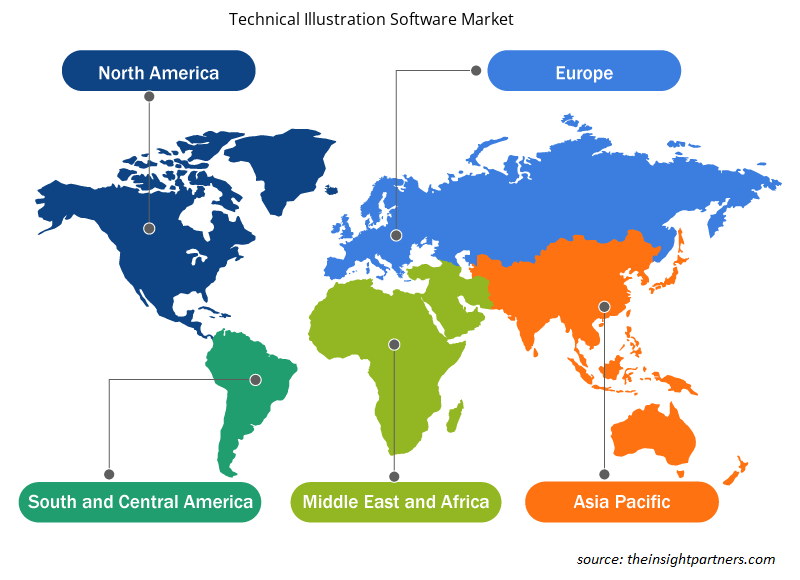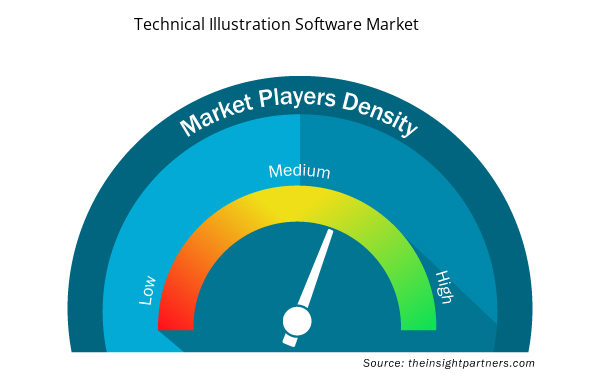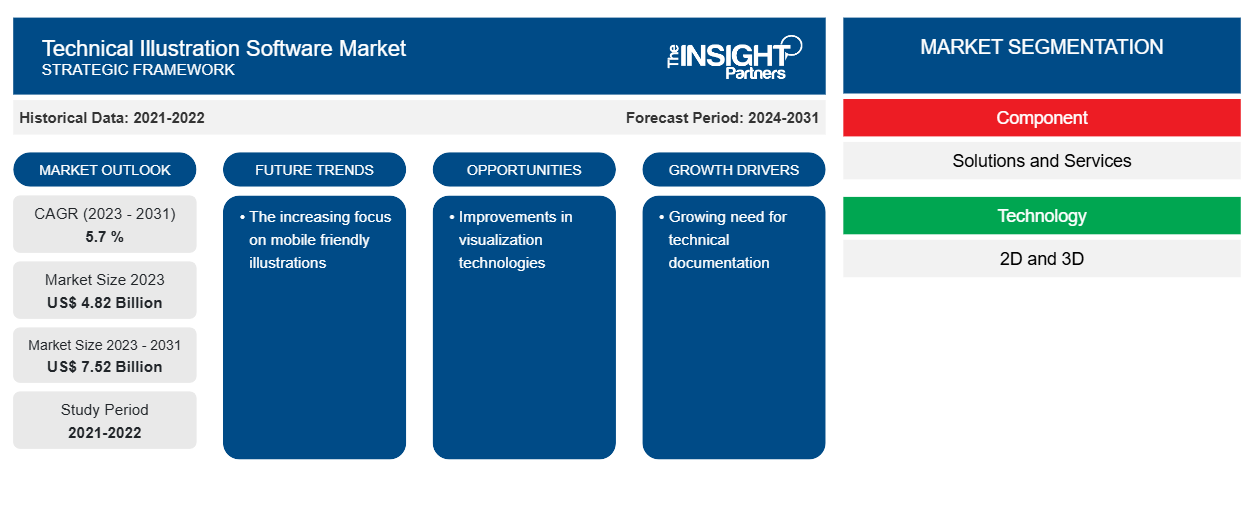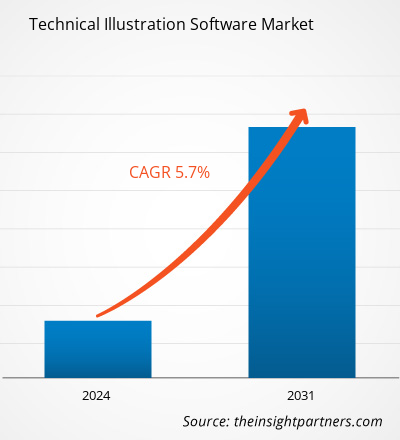Das Marktvolumen für technische Illustrationssoftware soll von 4,82 Milliarden US-Dollar im Jahr 2023 auf 7,52 Milliarden US-Dollar im Jahr 2031 anwachsen. Für den Markt wird für den Zeitraum 2023–2031 eine durchschnittliche jährliche Wachstumsrate (CAGR) von 5,7 % erwartet.Der zunehmende Fokus auf mobilfreundliche Illustrationen wird voraussichtlich ein wichtiger Trend auf dem Markt für technische Illustrationssoftware bleiben.
Marktanalyse für technische Illustrationssoftware
Software für technische Illustrationen Der Markt wird von den expandierenden Unterhaltungsbranchen und dem sich verändernden unternehmerischen Ökosystem verschiedener Branchen angetrieben. Mithilfe von Software für technische Illustrationen können Illustratoren technische Produkte leichter innerhalb einer festgelegten Zeitspanne entwerfen. Darüber hinaus bieten viele Softwareanbieter kostengünstige Optionen an, die kleine und mittlere Unternehmen, die normalerweise nur über begrenzte Ressourcen verfügen, problemlos erwerben können. Das größte Hindernis ist die Fülle an kostenlosen Tools auf dem Markt. Illustratoren benötigen diese kostenlosen Tools jedoch, um komplizierte technische Produkte zu entwerfen, und ihnen fehlen die umfassenden Funktionen und Möglichkeiten, die diese Tools erfordern. Daher geben Unternehmen trotz der Verfügbarkeit kostenloser Lösungen weiterhin Geld für den Kauf proprietärer Software aus.
Marktübersicht für technische Illustrationssoftware
Technische Zeichnungen und Produktbilder für Wissenschaft und Medizin sind in technischer Illustrationssoftware enthalten. Das Programm verfügt über eine Reihe von Eigenschaften, die Illustratoren benötigen, um technische Artikel zu entwickeln. Das Programm unterstützt sowohl die 2D- als auch die 3D-Designentwicklung. Von der Projektgestaltung und Erstellung bis hin zur Veröffentlichung technischer Dokumentation ermöglicht es die Erstellung komplexer technischer Grafiken mit vollständiger Kontrolle und Präzision. Das Programm wird hauptsächlich im Maschinenbau und für technische Zeichnungen medizinischer Geräte verwendet. Technische Illustrationssoftware eliminiert alle zusätzlichen Details. Darüber hinaus ermöglicht die Software künstlerische Freiheit bei der Anwendung mehrerer Stilelemente, um das Ziel der Illustration zu erreichen.
Passen Sie diesen Bericht Ihren Anforderungen an
Sie erhalten kostenlos individuelle Anpassungen an jedem Bericht, einschließlich Teilen dieses Berichts oder einer Analyse auf Länderebene, eines Excel-Datenpakets sowie tolle Angebote und Rabatte für Start-ups und Universitäten.
- Holen Sie sich die wichtigsten Markttrends aus diesem Bericht.Dieses KOSTENLOSE Beispiel umfasst eine Datenanalyse von Markttrends bis hin zu Schätzungen und Prognosen.
Treiber und Chancen auf dem Markt für technische Illustrationssoftware
Wachsender Bedarf an technischer Dokumentation
Die Automobil-, Luft- und Raumfahrt- , Verteidigungs-, Fertigungs- und Gesundheitsbranche gehören zu den zahlreichen expandierenden Branchen, in denen der Bedarf an klarer und genauer technischer Dokumentation gestiegen ist. Technische Handbücher, Montageanleitungen und Benutzerhandbücher können alle von den komplexen Schemata, Diagrammen und Bildern profitieren, die mithilfe von technischer Illustrationssoftware erstellt werden.
Verbesserungen bei Visualisierungstechnologien
Die ständigen Fortschritte in der Visualisierungstechnologie, wie 3D-Rendering, Augmented Reality (AR) und Virtual Reality (VR), treiben die Nachfrage nach technischer Illustrationssoftware voran. Diese Technologien ermöglichen es Benutzern, dynamische und interessante Visualisierungen zu erstellen, die die Kommunikation und das Verständnis komplexer technologischer Prozesse verbessern. Daher wird erwartet, dass die zunehmende Einführung des IoT den Akteuren auf dem Markt für technische Illustrationssoftware im Prognosezeitraum neue Möglichkeiten bietet.
Marktbericht zur technischen Illustrationssoftware – Segmentierungsanalyse
Wichtige Segmente, die zur Ableitung der Marktanalyse für technische Illustrationssoftware beigetragen haben, sind Komponenten und Endbenutzer.
- Basierend auf der Komponente ist der Markt für technische Illustrationssoftware in Lösungen und Dienste segmentiert.
- Nach Unternehmensgröße ist der Markt in KMU und Großunternehmen segmentiert. Das Segment der Großunternehmen hatte im Jahr 2023 einen größeren Marktanteil.
- Nach Technologie ist der Markt in 2D und 3D segmentiert.
- Nach Endverbraucher ist der Markt in die Branchen Fertigung, Luft- und Raumfahrt und Verteidigung, Automobil, Gesundheitswesen, Energie und Strom und Sonstige segmentiert.
Marktanteilsanalyse für technische Illustrationssoftware nach geografischer Lage
Der geografische Umfang des Marktberichts für technische Illustrationssoftware ist hauptsächlich in fünf Regionen unterteilt: Nordamerika, Asien-Pazifik, Europa, Naher Osten und Afrika sowie Südamerika/Süd- und Mittelamerika. In Bezug auf den Umsatz hatte Nordamerika den größten Marktanteil an technischer Illustrationssoftware. Der anhaltende Bedarf an kompletten technischen Illustrationssoftwarelösungen von Unternehmen in den Branchen Luft- und Raumfahrt und Militär, Fertigung und Gesundheitswesen ist einer der Faktoren, die die Expansion des Marktes vorantreiben.
Regionale Einblicke in den Markt für technische Illustrationssoftware
Die regionalen Trends und Faktoren, die den Markt für technische Illustrationssoftware während des Prognosezeitraums beeinflussen, wurden von den Analysten von Insight Partners ausführlich erläutert. In diesem Abschnitt werden auch die Marktsegmente und die Geografie von technischer Illustrationssoftware in Nordamerika, Europa, im asiatisch-pazifischen Raum, im Nahen Osten und Afrika sowie in Süd- und Mittelamerika erörtert.

- Erhalten Sie regionale Daten zum Markt für technische Illustrationssoftware
Umfang des Marktberichts zur technischen Illustrationssoftware
| Berichtsattribut | Details |
|---|---|
| Marktgröße im Jahr 2023 | 4,82 Milliarden US-Dollar |
| Marktgröße bis 2031 | 7,52 Milliarden US-Dollar |
| Globale CAGR (2023 - 2031) | 5,7 % |
| Historische Daten | 2021-2022 |
| Prognosezeitraum | 2024–2031 |
| Abgedeckte Segmente | Nach Komponente
|
| Abgedeckte Regionen und Länder | Nordamerika
|
| Marktführer und wichtige Unternehmensprofile |
|
Dichte der Marktteilnehmer für technische Illustrationssoftware: Die Auswirkungen auf die Geschäftsdynamik verstehen
Der Markt für technische Illustrationssoftware wächst rasant, angetrieben durch die steigende Nachfrage der Endnutzer aufgrund von Faktoren wie sich entwickelnden Verbraucherpräferenzen, technologischen Fortschritten und einem größeren Bewusstsein für die Vorteile des Produkts. Mit steigender Nachfrage erweitern Unternehmen ihr Angebot, entwickeln Innovationen, um die Bedürfnisse der Verbraucher zu erfüllen, und nutzen neue Trends, was das Marktwachstum weiter ankurbelt.
Die Marktteilnehmerdichte bezieht sich auf die Verteilung der Firmen oder Unternehmen, die in einem bestimmten Markt oder einer bestimmten Branche tätig sind. Sie gibt an, wie viele Wettbewerber (Marktteilnehmer) in einem bestimmten Marktraum im Verhältnis zu seiner Größe oder seinem gesamten Marktwert präsent sind.
Die wichtigsten auf dem Markt für technische Illustrationssoftware tätigen Unternehmen sind:
- ASA Computers, Inc.
- Autodesk, Inc
- Canvas GFX, Inc.
- Corel Corporation
- Cyient Ltd.
- Dassault Systemes
Haftungsausschluss : Die oben aufgeführten Unternehmen sind nicht in einer bestimmten Reihenfolge aufgeführt.

- Überblick über die wichtigsten Akteure auf dem Markt für technische Illustrationssoftware
Neuigkeiten und aktuelle Entwicklungen zum Markt für technische Illustrationssoftware
Der Markt für technische Illustrationssoftware wird durch die Erfassung qualitativer und quantitativer Daten nach Primär- und Sekundärforschung bewertet, die wichtige Unternehmensveröffentlichungen, Verbandsdaten und Datenbanken umfasst. Im Folgenden finden Sie eine Liste der Entwicklungen auf dem Markt für Sprach- und Sprechstörungen und Strategien:
- Im Januar 2021 gab Tech Soft 3D bekannt, dass Canvas GFX die HOOPS-Plattform nutzt, um seinem neuesten Produkt Canvas X3 3D-CAD-Modellfunktionen hinzuzufügen. Canvas X3 ist ein leistungsstarkes neues Produkt mit der Möglichkeit, Daten in mehr als 90 Dateiformaten zu importieren, darunter Dateien, die in allen führenden 3D-CAD-Paketen erstellt wurden. (Quelle: Tech Soft 3D, Pressemitteilung)
- Im Januar 2021 kündigte Canvas GFX, Inc., der führende Anbieter von technischer Illustrationssoftware, die kommerzielle Veröffentlichung seines neuesten Produkts, Canvas X3 CADComposer, an. (Quelle: Canvas GFX, Inc., Pressemitteilung)
Marktbericht zu technischer Illustrationssoftware – Abdeckung und Ergebnisse
Der Bericht „Marktgröße und Prognose für technische Illustrationssoftware (2021–2031)“ bietet eine detaillierte Analyse des Marktes, die die folgenden Bereiche abdeckt:
- Marktgröße und Prognose auf globaler, regionaler und Länderebene für alle wichtigen Marktsegmente, die im Rahmen des Projekts abgedeckt sind
- Marktdynamik wie Treiber, Beschränkungen und wichtige Chancen
- Wichtige Zukunftstrends
- Detaillierte PEST/Porters Five Forces- und SWOT-Analyse
- Globale und regionale Marktanalyse mit wichtigen Markttrends, wichtigen Akteuren, Vorschriften und aktuellen Marktentwicklungen
- Branchenlandschaft und Wettbewerbsanalyse, einschließlich Marktkonzentration, Heatmap-Analyse, prominenten Akteuren und aktuellen Entwicklungen
- Detaillierte Firmenprofile
- Historische Analyse (2 Jahre), Basisjahr, Prognose (7 Jahre) mit CAGR
- PEST- und SWOT-Analyse
- Marktgröße Wert/Volumen – Global, Regional, Land
- Branche und Wettbewerbsumfeld
- Excel-Datensatz



Report Coverage
Revenue forecast, Company Analysis, Industry landscape, Growth factors, and Trends

Segment Covered
This text is related
to segments covered.

Regional Scope
North America, Europe, Asia Pacific, Middle East & Africa, South & Central America

Country Scope
This text is related
to country scope.
Häufig gestellte Fragen
The global technical illustration software market was estimated to be US$ 4.82 billion in 2023 and is expected to grow at a CAGR of 5.7 % during the forecast period 2023 - 2031.
The growing need for technical documentation and improvements in visualization technologies are the major factors that propel the global technical illustration software market.
The increasing focus on mobile friendly illustrations is anticipated to play a significant role in the global technical illustration software market in the coming years.
The key players holding majority shares in the global technical illustration software market are ASA Computers, Inc., Autodesk, Inc., Canvas GFX, Inc., Corel Corporation, and Cyient Ltd.
The global technical illustration software market is expected to reach US$ 7.52 billion by 2031.
Trends and growth analysis reports related to Technology, Media and Telecommunications : READ MORE..
The Insight Partners performs research in 4 major stages: Data Collection & Secondary Research, Primary Research, Data Analysis and Data Triangulation & Final Review.
- Data Collection and Secondary Research:
As a market research and consulting firm operating from a decade, we have published and advised several client across the globe. First step for any study will start with an assessment of currently available data and insights from existing reports. Further, historical and current market information is collected from Investor Presentations, Annual Reports, SEC Filings, etc., and other information related to company’s performance and market positioning are gathered from Paid Databases (Factiva, Hoovers, and Reuters) and various other publications available in public domain.
Several associations trade associates, technical forums, institutes, societies and organization are accessed to gain technical as well as market related insights through their publications such as research papers, blogs and press releases related to the studies are referred to get cues about the market. Further, white papers, journals, magazines, and other news articles published in last 3 years are scrutinized and analyzed to understand the current market trends.
- Primary Research:
The primarily interview analysis comprise of data obtained from industry participants interview and answers to survey questions gathered by in-house primary team.
For primary research, interviews are conducted with industry experts/CEOs/Marketing Managers/VPs/Subject Matter Experts from both demand and supply side to get a 360-degree view of the market. The primary team conducts several interviews based on the complexity of the markets to understand the various market trends and dynamics which makes research more credible and precise.
A typical research interview fulfils the following functions:
- Provides first-hand information on the market size, market trends, growth trends, competitive landscape, and outlook
- Validates and strengthens in-house secondary research findings
- Develops the analysis team’s expertise and market understanding
Primary research involves email interactions and telephone interviews for each market, category, segment, and sub-segment across geographies. The participants who typically take part in such a process include, but are not limited to:
- Industry participants: VPs, business development managers, market intelligence managers and national sales managers
- Outside experts: Valuation experts, research analysts and key opinion leaders specializing in the electronics and semiconductor industry.
Below is the breakup of our primary respondents by company, designation, and region:

Once we receive the confirmation from primary research sources or primary respondents, we finalize the base year market estimation and forecast the data as per the macroeconomic and microeconomic factors assessed during data collection.
- Data Analysis:
Once data is validated through both secondary as well as primary respondents, we finalize the market estimations by hypothesis formulation and factor analysis at regional and country level.
- Macro-Economic Factor Analysis:
We analyse macroeconomic indicators such the gross domestic product (GDP), increase in the demand for goods and services across industries, technological advancement, regional economic growth, governmental policies, the influence of COVID-19, PEST analysis, and other aspects. This analysis aids in setting benchmarks for various nations/regions and approximating market splits. Additionally, the general trend of the aforementioned components aid in determining the market's development possibilities.
- Country Level Data:
Various factors that are especially aligned to the country are taken into account to determine the market size for a certain area and country, including the presence of vendors, such as headquarters and offices, the country's GDP, demand patterns, and industry growth. To comprehend the market dynamics for the nation, a number of growth variables, inhibitors, application areas, and current market trends are researched. The aforementioned elements aid in determining the country's overall market's growth potential.
- Company Profile:
The “Table of Contents” is formulated by listing and analyzing more than 25 - 30 companies operating in the market ecosystem across geographies. However, we profile only 10 companies as a standard practice in our syndicate reports. These 10 companies comprise leading, emerging, and regional players. Nonetheless, our analysis is not restricted to the 10 listed companies, we also analyze other companies present in the market to develop a holistic view and understand the prevailing trends. The “Company Profiles” section in the report covers key facts, business description, products & services, financial information, SWOT analysis, and key developments. The financial information presented is extracted from the annual reports and official documents of the publicly listed companies. Upon collecting the information for the sections of respective companies, we verify them via various primary sources and then compile the data in respective company profiles. The company level information helps us in deriving the base number as well as in forecasting the market size.
- Developing Base Number:
Aggregation of sales statistics (2020-2022) and macro-economic factor, and other secondary and primary research insights are utilized to arrive at base number and related market shares for 2022. The data gaps are identified in this step and relevant market data is analyzed, collected from paid primary interviews or databases. On finalizing the base year market size, forecasts are developed on the basis of macro-economic, industry and market growth factors and company level analysis.
- Data Triangulation and Final Review:
The market findings and base year market size calculations are validated from supply as well as demand side. Demand side validations are based on macro-economic factor analysis and benchmarks for respective regions and countries. In case of supply side validations, revenues of major companies are estimated (in case not available) based on industry benchmark, approximate number of employees, product portfolio, and primary interviews revenues are gathered. Further revenue from target product/service segment is assessed to avoid overshooting of market statistics. In case of heavy deviations between supply and demand side values, all thes steps are repeated to achieve synchronization.
We follow an iterative model, wherein we share our research findings with Subject Matter Experts (SME’s) and Key Opinion Leaders (KOLs) until consensus view of the market is not formulated – this model negates any drastic deviation in the opinions of experts. Only validated and universally acceptable research findings are quoted in our reports.
We have important check points that we use to validate our research findings – which we call – data triangulation, where we validate the information, we generate from secondary sources with primary interviews and then we re-validate with our internal data bases and Subject matter experts. This comprehensive model enables us to deliver high quality, reliable data in shortest possible time.


 Holen Sie sich ein kostenloses Muster für diesen Bericht
Holen Sie sich ein kostenloses Muster für diesen Bericht